July 2024
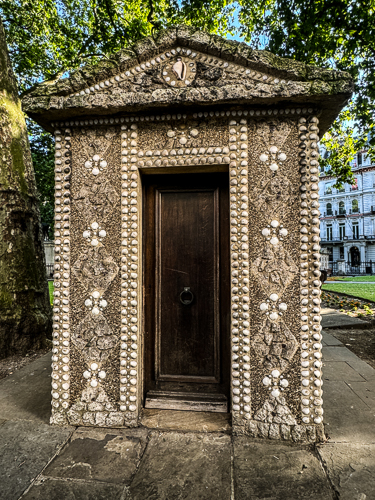 There are two of these unique huts in Grosvenor Gardens. The Gardens have been known as “London’s French Garden” since at least 1952. The Gardens were used as air raid shelters during the Second World War. After the war, it was decided that the gardens needed smartening up, and the huts were installed as part of this makeover. They were designed by French architect Jean-Charles Moreux and are decorated with both French and English shells to signify the links between the two countries. Why shells? It’s not entirely clear.
There are two of these unique huts in Grosvenor Gardens. The Gardens have been known as “London’s French Garden” since at least 1952. The Gardens were used as air raid shelters during the Second World War. After the war, it was decided that the gardens needed smartening up, and the huts were installed as part of this makeover. They were designed by French architect Jean-Charles Moreux and are decorated with both French and English shells to signify the links between the two countries. Why shells? It’s not entirely clear.
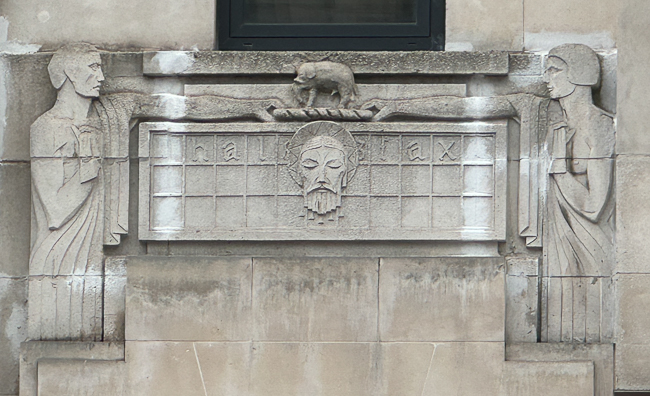
Halifax Building London
Walking down the Strand, I was struck by this ornament over a door. The most I could find was that it was built in the 1930s.
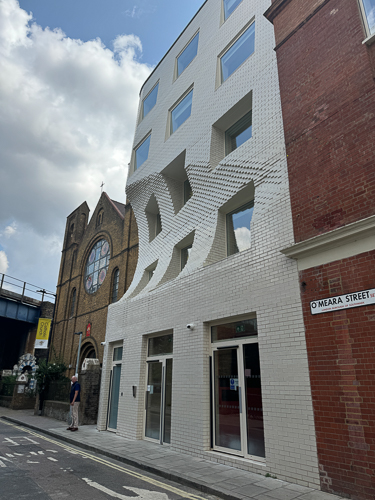
The Ice Cream Scoop Building
I had read about this building in the Guardian earlier in the year, and then I just tripped upon it this week. It sits at the corner of Union and O’Meara Streets. It is a white brick building with a furrow gouged out of its facade, giving it the nickname The Ice Cream Scoop Building. According to the architect, Jonny Plant of Lipton Plant: “We wanted to respect our neighbor. The church had always been overlooked, tucked down the side street next to the railway viaduct, so we wanted to celebrate it and draw people’s attention to it.” “The developer originally wanted to fill the whole site and bring the building right up to the street edge,” says Father Christopher Pearson, priest of the Church of Most Precious Blood. “But we had just spent a lot of money restoring the church, and we didn’t want to be hidden. They were very accommodating and listened to our concerns – and we are tickled pink with the result.”
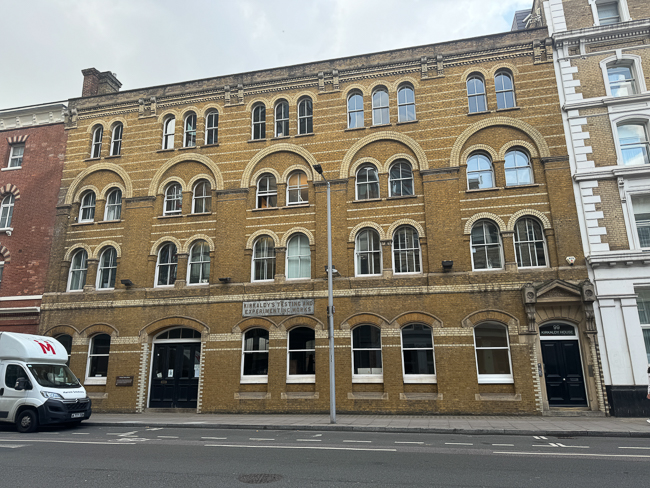
Kirkaldy’s Testing and Experiment Works
This building has a very unique history.
In 1862, engineer David Kirkaldy (1820-1897) published the results of several years of systematic testing he performed on wrought iron and steel. This work put him in a realm with engineers like Bazalgette, Bessemer, and Brunel. Kirkaldy’s Testing Works established the scientific testing of structural building materials. As well as tests on columns, links girders, and other materials like concrete, bricks, and wood, the Testing Works carried out forensic testing on failed structures. Kirkaldy’s most famous forensic test was in 1880, when he examined pieces recovered from the fatal collapse of the Tay Bridge. His findings, in contradiction to the view of the official Court of Inquiry, were one of the reasons his 1897 obituary in The Engineer described him as “honest as the sun; outspoken and fearless as a Viking” as well as being “the best-hated man in London”.
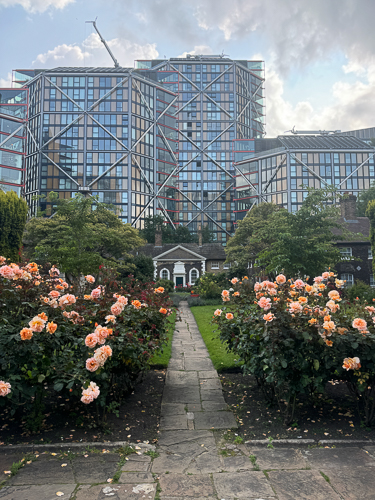
The rose garden first caught my eye when wandering down an alley, and after peeking into the garden, I found this quaint building. It is the Hopton’s Almshouse. Charles Hopton (born c.1654) was born into a wealthy merchant family and was admitted to the Guild of Fishmongers as a child. On his death in 1731, his will provided for almshouses to be built in the parish of Christchurch, Blackfriars for poor, single men. By 1746, 26 cottages had been completed, and they have been continuously occupied since July 1752. In 1988, twenty cottages were modernized and are supported by donations to the original trust created by Charles Hopton.
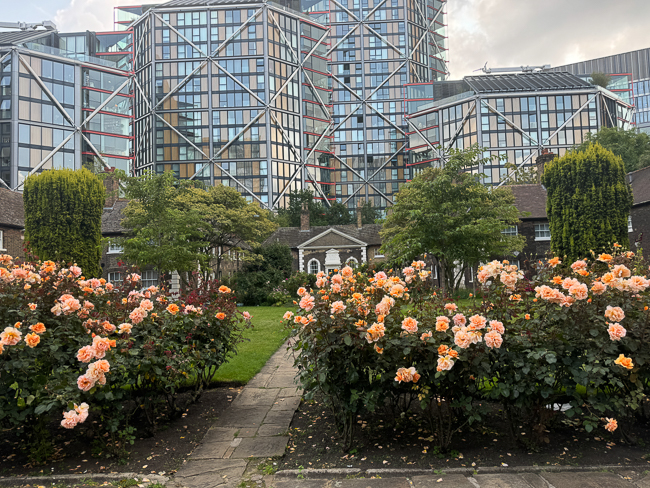

An old hayloft and hoist maintained in the modernization of a building near Borough Market
After a day of dragons at the Royal Pavillion in Brighton, I walked past this statue on the way to my hotel from Blackfriars tube station. I had walked past it before, but it felt so appropriate to take a picture this time.
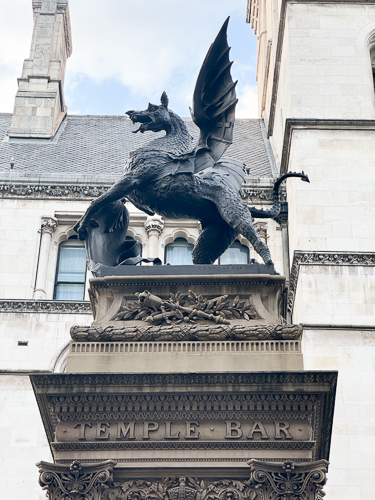
The Temple Bar Memorial
The Temple Bar Memorial stands where The Strand becomes Fleet Street and marks the Western entrance to the City of London from Westminster. It stands outside the Royal Courts of Justice where Temple Bar, a stone gate, once stood. Designed by the City of London architect Sir Horace Jones, Charles Bell Birch sculpted the bronze dragon; it was erected in 1880.
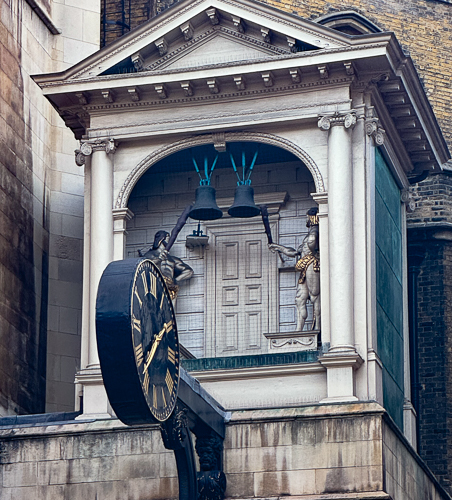 These two figures look over one of the two timepieces on the façade of the Fleet Street church, St Dunstan-in-the-West. It is believed to be the first public clock in London to include a minute hand. The clock and the figures were installed on the front of the church in 1671. The clock sticks out from the front of the church and features faces on both sides so that passers-by can see the time from either direction. The figures are automata, equipped with mechanisms that allow their heads to turn and arms to move, striking bells to mark the hour and quarter-hour.
These two figures look over one of the two timepieces on the façade of the Fleet Street church, St Dunstan-in-the-West. It is believed to be the first public clock in London to include a minute hand. The clock and the figures were installed on the front of the church in 1671. The clock sticks out from the front of the church and features faces on both sides so that passers-by can see the time from either direction. The figures are automata, equipped with mechanisms that allow their heads to turn and arms to move, striking bells to mark the hour and quarter-hour.
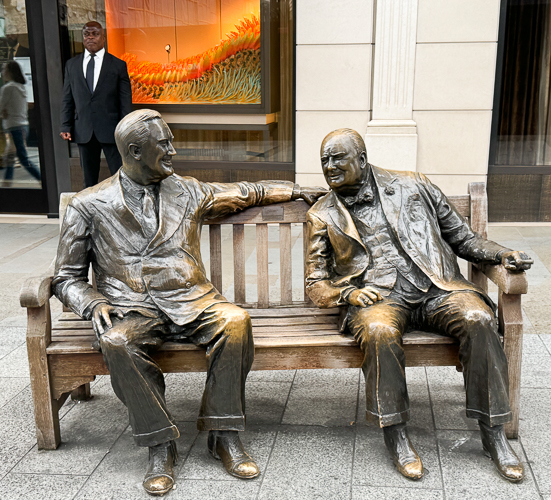
The statue, named ‘Allies,’ was created in 1995 by British-American sculptor Lawrence Holofcener. He was commissioned by the Bond Street Association, and Princess Margaret unveiled the statue on May 2, 1995, to commemorate 50 years of peace. It features Franklin D. Roosevelt and Winston Churchill, their faces crafted into permanent smiles as they share a silent joke. 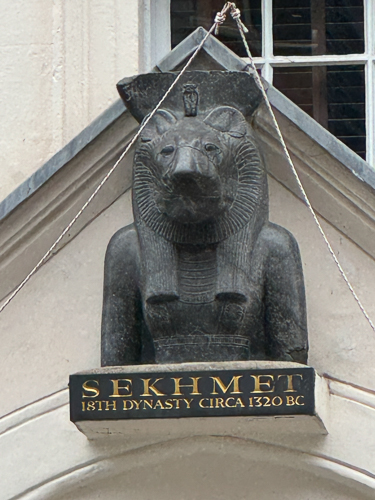
In front of Sotheby’s is Sekhmet, the goddess of healing in the Egyptian pantheon. The goddess is said to have formed the desert with her breath, led Egyptian warriors into battle, and protected the pharaohs. Based on its style, Sotheby’s Sekhmet dates between 1390 and 1352 BCE, making it the oldest outdoor statue in London.

Isokon was established in 1934 as one of Britain’s earliest examples of Modernist architecture. It is the creation of Jack and Molly Pritchard and architect Wells Coates. Their debut project was to design an apartment building and its interior based on the principle of affordable, communal, and well-designed inner-city living.
Jack Pritchard’s altruistic penchant for sheltering refugees from Nazi Europe attracted famous residents—among them architect and designer Marcel Breuer, painter László Moholy-Nagy, and Bauhaus founder Walter Gropius. An Austrian Isokon resident, Arnold Deutsch, was revealed to be a Soviet spy. The building’s opening was photographed by Edith Tudor Hart, herself a Soviet agent. Agatha Christie also lived in the building with her archeologist husband, Max Mallowan, when her Cornish house was requisitioned by the army and her London property was too exposed to bombing.
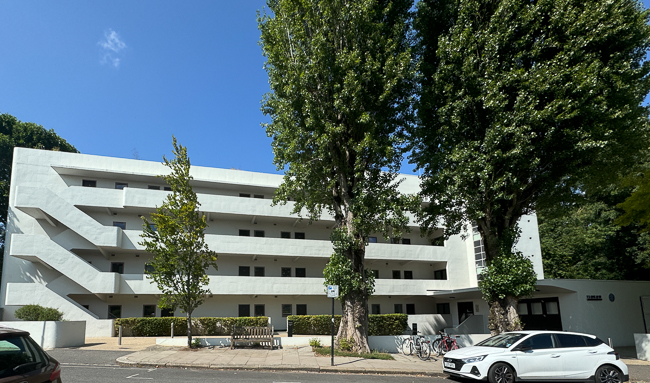
The name comes from Isometric Construction drawings, a 3D-looking type of architectural drawing popular at the time.
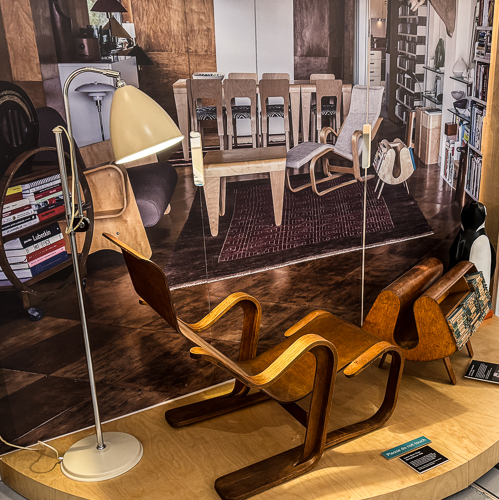
I have always loved the Penguin Donkey ( magazine/book rack) on the bottom right.
Jack Pritchard worked as Marketing Manager for Venesta, the world’s largest plywood manufacturer at the time. He was tasked with finding new uses for plywood; until the 1920s, they had mainly made tea chests for importing tea leaves from India, hat boxes, and food containers. Pritchard hired the designer Charlotte Perriand through the architectural firm of Le Corbusier to design a trade fair stand for Venesta at Olympia, London, in 1929. Together with Coates, the Pritchards formed Isokon with the idea of building modern houses and furniture.
You can still buy this furniture, although it is now made by Isokon Plus, formerly known as Windmill Furniture, under license from the Pritchard family.

Artist living in the neighborhood
The Hampstead Modernists lived within and around Isokon in the Hampstead-Belsize Park area. In the 1930s, Hampstead was the heart of the socialist intellectual and artistic crowd, a neighborhood of Bauhaus émigrés, artists, and rebels who had fairly unconventional domestic arrangements, ‘open-door policy’ marriages, and an ethos of ‘how best to love and live’.
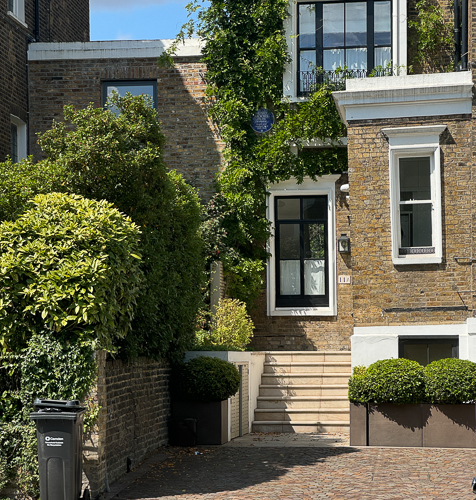
Piet Cornelis Mondrian lived here.
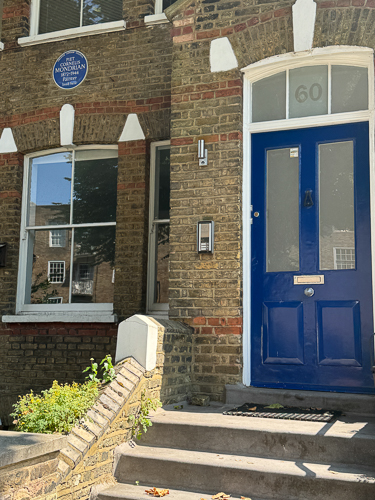
Henry Moore lived here from 1929-1949.
Until Next Time:
London Restaurants to Remember
Otto’s – An old classic experience of attentive waiters, rich French food, and a unique room. 182 Gray’s Inn Road – SO MUCH FUN!
Daphne’s – It was the friends rather than the restaurant. The food is excellent, the rooms are great, the wine list is very expensive, and the service needs work. 112 Draycot Avenue
Coppa Club Tower Bridge – You go for the view. I enjoyed the evening with good friends, wine, and small plates.
The Portrait – a Restaurant on top of the Portrait Gallery. It offers Great views, great food, fair service. I enjoyed a meal with special friends, which always adds to the fun.
This trip I saw two highly recommendable plays. Operation Mincemeat and The Constituant.